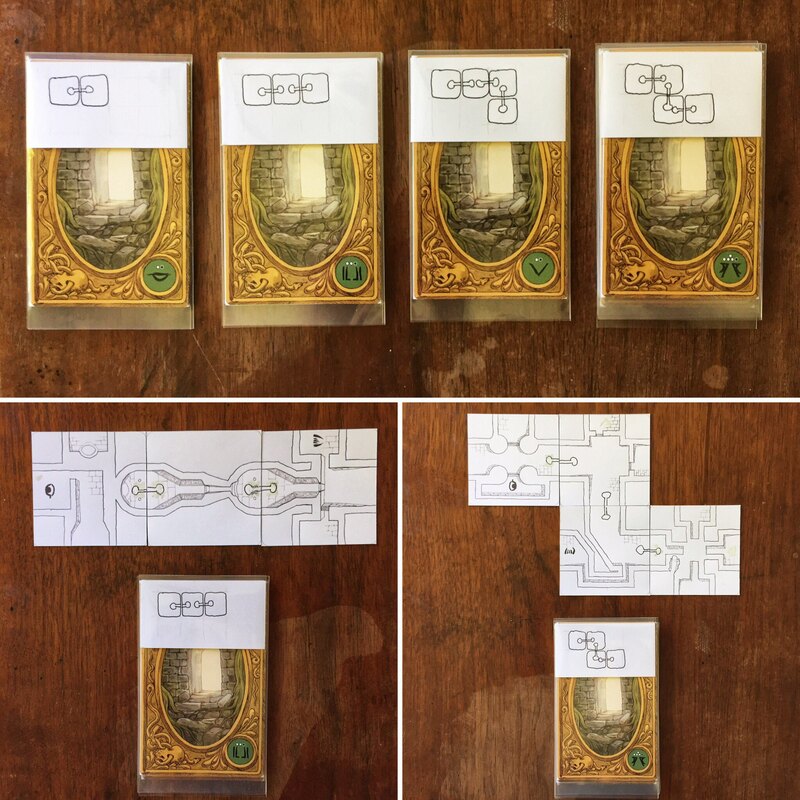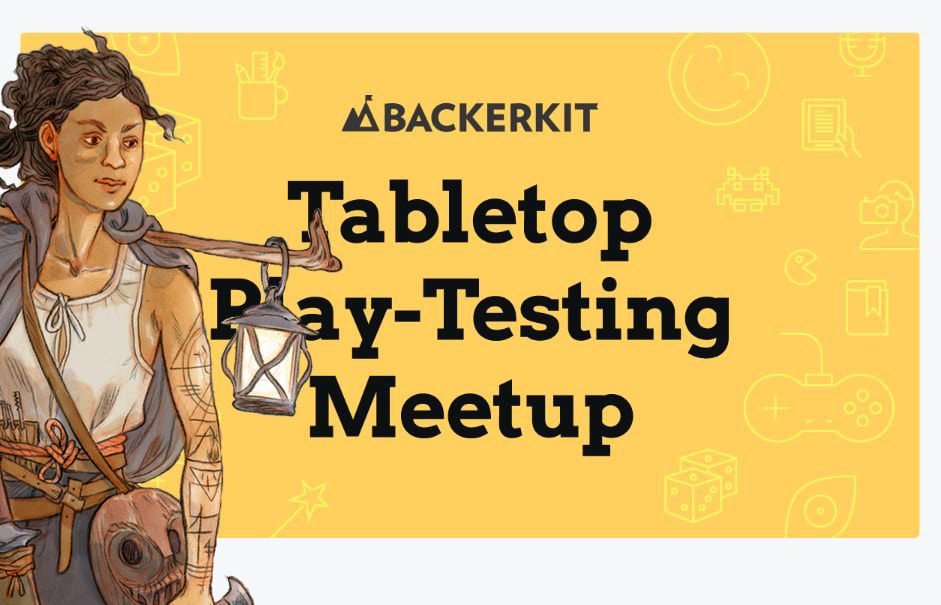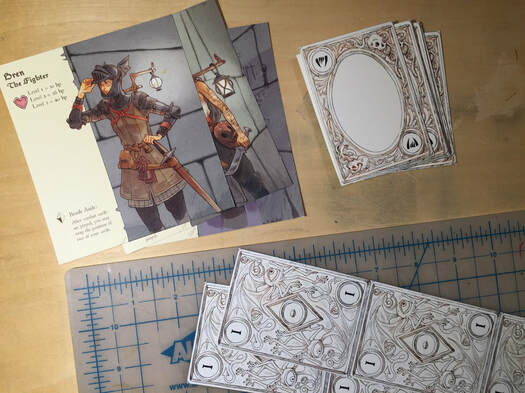|
I'm pleased to announce I've got a demo of Forgotten Depths built for Tabletop Simulator!
It presents the full content (with prototype components) for 1-3 players to play the firs ecology in the game, The Ruins.
1 Comment
I'm happy to say a Work-In-Progress version of the rulebook is available for download.
Just hit the button below to grab the pdf, and feel free to shoot me any comments or questions you might have! Tracking the hit points of Heroes and their foes is a critical part of gameplay. It needs to be a simple, quick process, and it needs to provide immediate visual information on combatants current health.
Until a couple months ago, I'd been doing this with health tokens in denominations of 1, 3, and 5. This posed multiple issues; it was fiddly, took too long to upkeep every round, and to "read" a combatants health you had to tally coins and do a calculation. It also made it hard for Heroes to know their allies health without asking them, then waiting for them to tally, calculate and respond. This was especially bad since round by round combat decisions want to be informed by the Heroes health states. Thankfully, an astute playtester presented a better solution, and the health track was born! Much like a VP track in other boardgames, the health track is a common strip of values where all Heroes and Monsters track their health with different colored discs. In the middle image above, you can see it in action, with Bren's black disc, Sil's blue disc, and a single Monster's purple disc. This way, tracking health is fast, all the values are readily legible, and you see their relationship to each other at a glance. Brilliant! forgotten depths now supports 3-player and a true solo 1-player mode! (without the need for automa!)6/22/2019 This won't come as a surprise to anyone who has played the game recently, but for those who haven't seen it in the last couple of months, the game has been modified to support 3 players, as well as a true solo 1 player mode.
Like many of the game's greatest aspects, this change was a direct response to player feedback. I'd hear, "there's three heroes, why can't I play 3-player?" A good question! At the time, the way combat was designed didn't make that easy to do. Since, I was also hearing comments on what people liked and disliked about the combat, and had aspects I wanted to improve there, I took a couple weeks and really rearranged the combat mechanic. The result? Combat feels more satisfying to the player (more frequent, bigger successes), player agency increased (more ability to affect combat results in a given round), and scaling from 1 to 3 players is as simple as reading a different numeric value from the Monster of Feature you're facing. Slick! As you can see in the example below, Monster's have three hit point values based on a 1-player, 2-player, or 3-player game. When Features introduce challenges that have numeric targets, the same thing appears. What's really cool, is this is the only thing that changes between a 1, 2, or 3 player game. I had the great pleasure of presenting Forgotten Depths to the fine people of Boardgamegeek yesterday. Have a look! Each dungeon ecology in the game has four special locations that can only be discovered by configuring the map tiles in a specific combination. These Legendary Locations provide expanded text descriptions and art, and often hold special encounters and treasure. They also always provide a nice little pile of experience points, something the players are always after given the many useful ways it can be spent.
So Legendary Locations are meant to be rare and special discoveries, which the tile configuration requirements creates. Players are aware up front about what it takes to build their existence into the map, and they need to pay attention as they place map tiles if they hope to successfully "locate" one of them. Until recently, the specific combination had to do with pairing matched symbols on map tile edges. Each Legendary Location had a specific symbol associated with it, and only that symbol could be paired with another like it to create the location. Players have loved the overall concept, but a comment I heard in back-to-back play test sessions was that it would be better if the symbols were more generic and interchangeable in some way. In other words, these players were asking for more flexibility in creating the locations. As another game designer once shared with me, "The first time you hear a comment it's an opinion. The second time you hear it it's an idea." So I gave it some thought, and I've come up with a solution that's been testing very well so far. The essential change is that now the tile combination requirements have to do with linking multiple tiles together to create a specifically configured shape. Before it was about matching one of the two available tiles with a specific symbol on it, with the other tile with that specific symbol on it. Now there are multiple "end" pieces, "straight middle segments," and "L's" that can all be used interchangeably to form any of the configurations. The pieces are limited, and some locations are mutually exclusive, so they still feel rare. They also still take thought and skill to create, so they give a nice sense of achievement when you've built one. Lastly, the process is just more engaging now. You can see what I'm talking about in the prototype images above. The top picture shows the cards for all four Legendary Locations from the Ruins ecology. In the bottom right corner of the cards (in the green circle) you can see the old symbols from the previous matching method. The hand-drawn black and white diagrams I've slipped into the card sleeves at their tops show the new tile configurations. The two bottom pictures show examples of what it looks like to have the map tiles configured correctly to match specific locations. These kinds of changes are great. The core mechanic stays intact, things don't get any more complicated for the player, and play is experience is enhanced. I love it! :) Stay tuned for the next post, which will talk about the other great change I've implemented due to tester feedback... The Backerkit Play-Test Meetup last Wednesday was excellent. It's really great they open their space up for it once a month. It's a fantastic venue, and seems to be drawing a steady crowd of designers and players.
Play-testing Forgotten Depths went very well. I ran two different groups of players through the Ruins in one evening which is a first. There were a couple things I tried differently after feedback at Victory Point Cafe the week before... Things I tried differently, in order of importance: 1. Heroes discard all Action Cards left in their Hand each Combat Round (rather than hang on to them) 2. Each Hero starts with an "Block Ability," which they may Activate when a Block occurs in Combat. This is in addition to their starting Abilities Activated by Spending Power Cards. 3. Heroes start the game with both their Power Cards Stored (rather than having to Draw into them) Item 1 let players skip out on playing their lowest cards, which skewed Combat pretty far toward easy. There's other things I could change to adjust the difficulty, but the bigger issue is that it also cut out some of the tactical card-playing nuance. This one aspect is probably worth it's own post actually. I'll likely do just that to kick off a new "mechanics" thread soon. Items 2 and 3 were slam dunks. Both were ideas taken directly from tester feedback over at Victory Point. (Thank you A. & V.!) Starting Heroes with one more Ability just helps them to be more fun and interesting right out of the gates. I'd worried about making them too complex starting out, but this feels pretty right. Tying it to Blocks in Combat separates it from the entire Power-Card-for-Ability loop, which helps players hold it in mind alongside their other Ability. And starting Heroes with both their Power Cards Stored was a simple way to put tactical agency immediately into player's hands. Perfect. Also, somewhat inadvertently, I'd messed with the mix of corridor shapes in the Map Tiles, which resulted in some cake-walk Exploration. I'm working to get each level's Tile count down to 20, and I'd just finished drawing up nicer versions of the Ruins tiles to use at the play-test. In the process however, I included too many 3 and 4 way intersections, and dropped out a couple key 2 way tiles that made level building more risky and tense. (dead ending your Explored Area means losing the game) That's an easy fix. I've dug back out the ones I need to include, and I'll replace a couple of the 3 and 4 way Tiles with them while keeping the total to 20 Tiles. That's it for now! Some photos from the night are below. Pete
|
AuthorVoid Knight Games Archives
September 2020
Categories |
















 RSS Feed
RSS Feed
